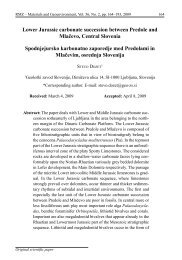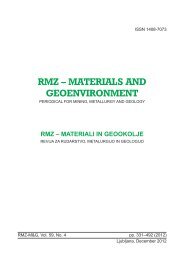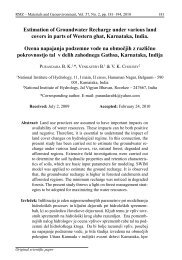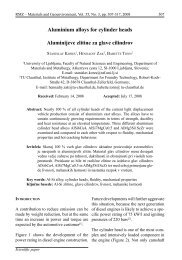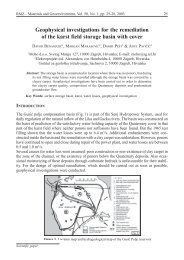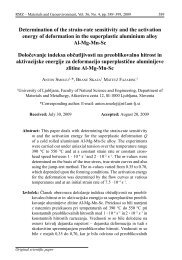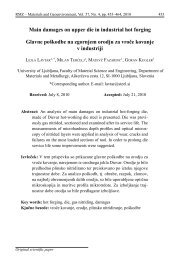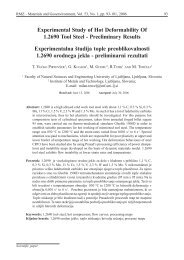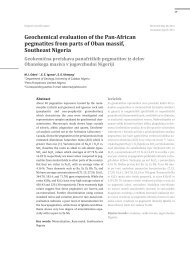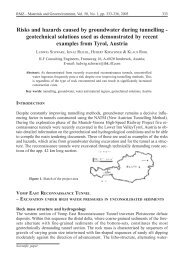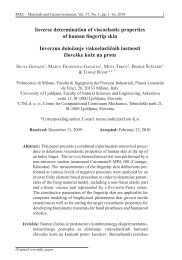Durability evaluation of some Slovenian building limestones ... - RMZ
Durability evaluation of some Slovenian building limestones ... - RMZ
Durability evaluation of some Slovenian building limestones ... - RMZ
Create successful ePaper yourself
Turn your PDF publications into a flip-book with our unique Google optimized e-Paper software.
<strong>Durability</strong> <strong>evaluation</strong> <strong>of</strong> <strong>some</strong> <strong>Slovenian</strong> <strong>building</strong> <strong>limestones</strong><br />
333<br />
result it was considered as popular as<br />
marble, being widely used particularly<br />
in baroque architecture not only<br />
in Ljubljana, but also in other regions<br />
<strong>of</strong> Slovenia. Many interior and exterior<br />
architectural elements and monuments,<br />
especially the portals <strong>of</strong> houses<br />
and altars, were made <strong>of</strong> this limestone<br />
(Ramovš, 2000). However, both <strong>limestones</strong><br />
are at risk when exposed to certain<br />
climatic conditions, with chromatic<br />
and salt weathering recognised as the<br />
phenomena most responsible for their<br />
deterioration (Kramar et al., 2010a;<br />
Kramar et al., 2010b).<br />
In order to estimate the weathering<br />
behaviour <strong>of</strong> the selected <strong>limestones</strong>,<br />
samples were subjected to the salt crystallisation<br />
test and freeze/thaw cycles.<br />
Changes in the mechanical-physical<br />
properties <strong>of</strong> the <strong>limestones</strong> after these<br />
ageing tests were estimated via ultrasonic<br />
velocity measurements and SEM<br />
examination. In addition, the splitting<br />
tensile strength <strong>of</strong> the fresh <strong>limestones</strong><br />
was also determined.<br />
Materials and methods<br />
Materials<br />
For the study, two <strong>Slovenian</strong> <strong>limestones</strong><br />
were selected; Lesno Brdo and<br />
Drenov Grič. Samples <strong>of</strong> Drenov Grič<br />
limestone (DG) were collected from<br />
the main quarry in Drenov Grič near<br />
Ljubljana (Figure 1a), which historically<br />
had a leading role in supplying<br />
<strong>building</strong> material to central parts <strong>of</strong><br />
Slovenia (Ramovš, 2000). This Triassic<br />
well-stratified limestone occurs in<br />
10–80 cm thick beds, which alternate<br />
with thin sheets <strong>of</strong> marls. The Drenov<br />
Grič limestone is considered one <strong>of</strong> the<br />
most beautiful <strong>Slovenian</strong> natural stones<br />
due to its typical black colour interwoven<br />
with white veins (Figure 1b). Fragments<br />
<strong>of</strong> fossil bivalvia, gastropoda, algae,<br />
foraminifera, ostracods and corals<br />
are also occasionally found (Ramovš,<br />
2000). Samples <strong>of</strong> Lesno Brdo limestone<br />
were taken from the still active<br />
local quarry <strong>of</strong> Lesno Brdo near Ljubljana<br />
(Figure 2a). Two lithotypes <strong>of</strong><br />
this Triassic reef limestone were selected:<br />
the dark grey lithotype – SLB<br />
(Figure 2b) and the light red lithotype<br />
- PLB (Figure 2c). Lesno Brdo limestone<br />
is heterogeneous, composed <strong>of</strong><br />
intraclasts, pellets and fossil fragments.<br />
Coloured (violet, red, green and white)<br />
veins and styloliths filled with phyllosilicates<br />
or iron oxides/hydroxides are<br />
also present, along with large yellow<br />
or violet dolomite crystals (Ramovš,<br />
2000).<br />
Analytical methods<br />
Analysis <strong>of</strong> the <strong>limestones</strong>’ splitting tensile<br />
strength was performed according to<br />
SIST EN 12390-6, using a ZWICK apparatus<br />
b24, type Z 400 E. Samples took<br />
the form <strong>of</strong> (50 × 50 × 50) mm cubes,<br />
<strong>RMZ</strong>-M&G 2010, 57



